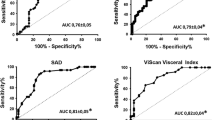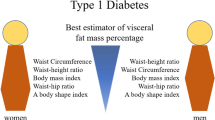Abstract
Metabolic syndrome (MS) is an important cardiovascular risk factor and visceral fat plays a central role in its development. Visceral fat measurement by TC or MRI is difficult to apply in routine clinical practice. Our aim was to evaluate anthropometric measurements, abdominal ultrasonography (US) and a new abdominal bioelectrical impedance analysis (BIA) (ViScan, TANITA) as predictors of metabolic abnormalities. 105 subjects, (age 52.8 ± 14.7 years, BMI of 29.2 ± 5.3 kg/m2) were analysed. Total cholesterol, HDL-cholesterol, triglycerides, glucose, insulin, adipochine and inflammatory citochines were determined. Waist and hip circumferences and sagittal abdominal diameter (SAD) were measured and abdominal BIA with ViScan was performed; peri-renal, para-renal, peri-hepatic, pre-peritoneal, and peritoneal fat thicknesses were measured by US Anthropometric indexes, ViScan and US measurements were evaluated as predictors of MS abnormalities in a partial correlation analysis adjusted for BMI. Only SAD and peritoneal US fat thickness are good predictors for the metabolic abnormalities related to MS after adjusting for BMI. The correlation among different anthropometric, abdominal BIA and ultrasonographic measurements, corrected for BMI, showed that SAD had a strong correlation with peritoneal fat thicknesses. Both SAD and US peritoneal fat thickness are good predictors of metabolic abnormalities.
Similar content being viewed by others
References
Executive summary of third report of the National Cholesterol Education Program (NCEP) (2001) Expert Panel on detection, evalutation, and treatment of high blood cholesterol in adults (Adult Treatement Panel III). JAMA 285(19):2486–2497
Eckel RH, Grundy SM, Zimmet PZ (2005) The metabolic syndrome. Lancet 365:1415–1428
Grundy SM (2008) Metabolic syndrome pandemic. Arterioscler Thromb Vasc Biol 28:629–636
Bosello O, Zamboni M (2000) Visceral obesity and metabolic syndrome. Obes Rev 1:47–56
Visscher TL, Seidell JC, Molarius A, van der Kuip D, Hofman A, Witteman JC (2001) A comparison of body mass index, waist-hip ratio and waist circumference as predictors of all-cause mortality among the elderly: the Rotterdam study. Int J Obes 25:1730–1735
Peiris AN, Sothmann MS, Hoffmann RG, Hennes MI, Wilson CR, Gustafson AB et al (1989) Adiposity, fat distribution, and cardiovascular risk. Ann Intern Med 110:867–872
Alberti KG, Zimmet P, Shaw J, IDF Epidemiology Task Force Consensus Group (2005) The metabolic syndrome–a new worldwide definition. Lancet 366:1059–1062
National Institutes of Health (1998) Clinical guidelines on the identification, evaluation, and treatment of overweight and obesity in adults: the evidence report. Obes Res 6:51S–209S
Busetto L, Baggio MB, Zurlo F, Carraro R, Digito M, Enzi G (1992) Assessment of abdominal fat distribution in obese patients: anthropometry versus computerized tomography. Int J Obes 16:731–736
Armellini F, Zamboni M, Harris T, Micciolo R, Bosello O (1997) Sagittal diameter minus subcutaneous thickness. An easy to obtain parameter that improves visceral fat prediction. Obes Res 5:315–320
Thomas EL, Collins AL, McCarthy J, Fitzpatrick J, Durighel G, Goldstone AP et al (2010) Estimation of abdominal fat compartments by bioelectrical impedance: the validity of the ViScan measurement system in comparison with MRI. Eur J Clin Nutr 64:525–533
Armellini F, Zamboni M, Rigo L, Todesco T, Bergamo-Andreis IA, Procacci C et al (1990) The contribution of sonography to the measurement of intra-abdominal fat. J Clin Ultrasound 18:563–567
Kawasaki S, Aoki K, Hasegawa O, Numata K, Tanaka K, Shibata N et al (2007) Sonographic evaluation of visceral fat by measuring para- and perirenal fat. J Clin Ultrasound 36:129–133
Lirussi F, Vitturi N, Azzalini L, Orando S, Orlando R, Plebani M et al (2009) Perihepatic adipose tissue thickness: a new non-invasive marker of NAFLD? J Gastrointestin Liver Dis. 18(1):61–66
Suzuki R, Wantanabe S, Hirai Y, Akiyama K, Nishide T, Matsushima Y et al (1993) Abdominal wall fat index, estimated by ultrasonagraphy, for assessment of the ratio of visceral fat to subcutaneous fat in the abdomen. Am J Med 95:309–314
Riley TR, Bruno MA (2005) Sonographic measurement of the thickness of subcutaneous tissue in non-alcoholic fatty liver disease versus other chronic liver disease. J Clin Ultrasound 33:439–441
Fox CS, Massaro JM, Hoffmann U, Pou KM, Maurovich-Horvat P, Liu CY, Vasan RS, Murabito JM, Meigs JB, Cupples LA, D’Agostino RB Sr, O’Donnell CJ (2007) Abdominal visceral and subcutaneous adipose tissue compartments: association with metabolic risk factors in the Framingham heart study. Circulation 116:39–48
Kuk JL, Lee S, Heymsfield SB, Ross R (2005) Waist circumference and abdominal adipose tissue distribution: influence of age and sex. Am J Clin Nutr 81:1330–1334
Pou KM, Massaro JM, Hoffmann U, Lieb K, Vasan RS, O’Donnell CJ, Fox CS (2009) Patterns of abdominal fat distribution: the Framingham heart study. Diabetes Care 32:481–485
Kvist H, Chowdhury B, Grangård U, Tylén U, Sjo¨ stro¨m L (1988) Total and visceral adipose tissue volumes derived from measurements with computed tomography in adult men and women: predicted equations. AmJ Clin Nutr 48:1351–1361
Van der Kooy K, Leenen R, Seidell JC, Deurenberg P, Visser M (1993) Abdominal diameters as indicators of visceral fat: comparison between magnetic resonance imaging and anthropometry. Br J Nutr 70:47–58 14
Zamboni M, Turcato E, Armellini F, Kahn HS, Zivelonghi A, Santana H, Bergamo-Andreis IA, Bosello O (1998) Sagittal abdominal diameter as a practical predictor of visceral fat. Int J Obes 22:655–660
Empana JP, Ducimetiere P, Charles MA, Jouven X (2004) Sagittal abdominal diameter and risk of sudden death in asymptomatic middle aged men: the Paris prospective study I. Circulation 110:2781–2785
Risérus U, Arnlo¨v J, Brismar K, Zethelius B B, Berglund L, Vessby B (2004) Sagittal abdominal diameter is a strong anthropometric marker of insulin resistance and hyperproinsulinemia in obese men. Diabetes Care 27:2041–2046
Shen W, Wang Z, Punyanita M, Lei J, Sinav A, Kral JG, Imielinska C, Ross R, Heymsfield SB (2003) Adipose tissue quantification by imaging methods: a proposed classification. Obes Res 11(1):5–16
Van der Kooy K, Seidell JC (1993) Techniques for the measurement of visceral fat: a practical guide. Int J Obes Relat Metab Disord 17:187–196
Stolk RP, Wink O, Zelissen PMJ, Meeijer R, von Gils APG, Grobbee DE (2001) validity and reproducibility of ultrasonography for the measurment of intraabdominal adipose tissue. Int J Obes 25:1346–1351
Bazzocchi A, Filonzi G, Ponti F, Sassi C, Salizzoni E, Battista G, Canini R (2011) Accuracy, reproducibility and repeatability of ultrasonography in the assessment of abdominal adiposity. Acad Radiol 18(9):1133–1143
Kim SK, Kim HJ, Hur KY, Choi SH, Ahn CW, Lim SK, Kim KR, Lee HC, Huh KB, Cha BS (2004) Visceral fat thickness measured by ultrasonography can estimate not only obesity but also risks of cardiovascular and metabolic disease. Am J Clin Nutr 79:593–599
Yim JY, Kim D, Lim SH, Park MJ, Choi SH, Lee CH, Kim SS, Cho SH (2010) Sagittal abdominal diameter is a strong anthropometric measure of visceral adipose tissue in the Asian general population. Diabetes Care 33:2665–2670
Yusuf S, Hawken S, Ounpuu S et al (2005) Obesity and the risk of myocardial infarction in 27,000 participants from 52 countries: a case-control study. Lancet 366:1640–1649
Conflict of interest
None.
Author information
Authors and Affiliations
Corresponding author
About this article
Cite this article
Soattin, M., De Stefano, F., Vitturi, N. et al. Anthropometry, ultrasonography and abdominal bio-electrical impedance as predictors of metabolic abnormalities in normal and obese subjects. Mediterr J Nutr Metab 6, 151–158 (2013). https://doi.org/10.1007/s12349-013-0129-z
Received:
Accepted:
Published:
Issue Date:
DOI: https://doi.org/10.1007/s12349-013-0129-z




